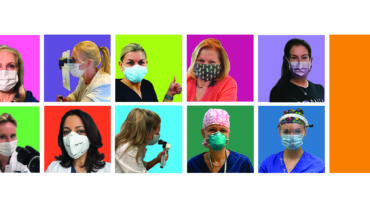The Impact of Special Precautions
Natalia Anisimova, MD, PhD
The World Health Organization declared COVID-19 a pandemic in March 2020.1 Transmission of SARS-CoV-2 is thought to occur through direct contact and exposure to airborne virus-laden particles.2 At an ophthalmology clinic, the close proximity of the ophthalmologist to the patient is a major risk factor for SARS-CoV-2 transmission. Early in the pandemic, elective ocular surgery and much routine ophthalmic care was therefore canceled. Many practices experienced financial problems, but the impact didn’t stop there.
EDUCATION
Training. The COVID-19 pandemic negatively affected residents and fellows. Skills transfer decreased, and training was discontinued for more than 6 months in some cases. The suspension of face-to-face training was partially offset by the rapid development of online resources. Early on, these consisted of chaotic informal lectures, and problems with connectivity were not uncommon. Soon, however, experience yielded higher-quality learning.
An area of particular interest to me is the development and use of simulators to facilitate training for residents and fellows and to speed the introduction of modern technologies into the practices of established ophthalmologists. I am a cofounder of one of these projects, NOE-VR, an educational virtual reality (VR) simulator with an AI interface. The idea is to allow users to gain clinical and surgical training through the use of a VR headset (Figure). A personal digital tutor tracks users’ progress and provides information on required corrections.

Figure. Simulation of an eye as seen with a VR headset.
Courtesy of Natalia Anisimova, MD, PhD; 3D graphics production by @Medicine3D, M. Vaulin
Compared to traditional education at a university, this approach permits physical distancing and thus decreases the risk of SARS-CoV-2 transmission. It is also possible that the use of VR and AI can shorten the learning curve for various aspects of ophthalmology training.
In-person versus remote learning.Lifelong learning is essential to the professional development of health care providers as well as to patient care. The cancellation of professional meetings presented a major obstacle, but again, online resources and events were developed in response. As presenters and audience members gained experience with online resources, this format became more intuitive for both. In time, the demand for webinars and online lectures and conferences increased, sometimes to a higher level than when the same events were conducted in person before the pandemic.
One issue with online resources that has become apparent is the need for easy navigation. Clear differentiation between skill levels is also required. The needs of ophthalmologists early in their careers, for example, are not the same as those of well-established surgeons. Moreover, users do not want to spend hours surfing social networks to find worthwhile webinars and lectures to gain new theoretical and practical skills. These areas require continued refinement.
THE DOCTOR-PATIENT RELATIONSHIP
Developing a rapport and building a foundation of trust with patients requires work. Effective communication is key to these efforts and to educating patients on their health and treatment. Wearing masks complicates matters. It can make it difficult to understand what someone is saying and obscure the wearer’s emotions. Patients may not be able to recognize who is treating them. Subconsciously, they may begin to doubt the provider’s sincerity. Uncertainty and decreased emotional connection can negatively influence not only patients’ adherence to prescribed therapy but also practitioners’ satisfaction with their profession. One response to these problems and COVID-19 restrictions has been the increased use of telehealth appointments, but challenges remain.
BURNOUT
For these and other reasons, burnout is a continuing concern during the pandemic. In health care, burnout is at an all-time high. Approximately one-third of health care workers reported in a recent poll that they had considered leaving the health care field because of the pandemic.3
There was no way to prepare for the fallout of the spread of SARS-CoV-2, and many ophthalmologists therefore experienced abrupt changes in their professional and personal activities. After the initial lockdowns, ophthalmologists were forced to reduce their workloads to account for social distancing in the clinic. High-volume surgeons with little to no time for their personal endeavors experienced the most notable change to their activities and were able to allocate more time for education and their personal lives than before the pandemic. Those and other surgeons felt enthusiastic early on about the wide variety of online educational resources to satisfy their professional hunger for theoretical and practical knowledge.
Even ophthalmologists who did not feel overworked before the pandemic felt an unpleasantness triggered by empty work hours, and time in the absence of professional activity seemed to pass more slowly. For some, unwinding after each workday became more difficult because of feelings of dissatisfaction. Complicating these feelings was knowing that we could do nothing more than observe patients with irreversible progression of eye disease during the early stages of the pandemic. No one was prepared for the feelings of anger, helplessness, and unfairness in knowing that, were it not for COVID-19, we would be able to care for patients properly, and symptoms of burnout persisted.
In order to mitigate the risk of burnout and alleviate the feelings of dissatisfaction at work, my colleagues and I used online resources to acquire cross-competencies. Most of us, however, noted that the online format of communication and education—although effective and convenient—was sterile without the opportunity to learn in person among a large number of smart, interesting people. For many, myself included, the value of educational events is not only the knowledge gained but also the social-professional communication, which often inspires deeper ambitions, ideas, and professional hunger for self-improvement.
1. World Health Organization. Virtual press conference on COVID-19. March 11, 2020. Accessed April 27, 2021. https://www.who.int/docs/default-source/coronaviruse/transcripts/who-audio-emergencies-coronavirus-press-conference-full-and-final-11mar2020.pdf?sfvrsn=cb432bb3_2
2. Morawska L, Cao J. Airborne transmission of SARS-CoV-2: the world should face the reality. Environ Int. 2020;139:105730.
3. KFF and Washington Post frontline health care workers survey. Washington Post. March 2021. Accessed May 10, 2021. https://context-cdn.washingtonpost.com/notes/prod/default/documents/4d8d1ddf-c192-40f9-9e3a-7a3fefa0d928/note/91e5f1ac-2cc5-41bb-b164-ecb4d77ed0b5.#page=1
Plan Now for Future Pandemics
Marie-José Tassignon, MD, PhD, FEBOS-CR
More than a year after the first COVID-19 lockdown, it is obvious that the spread of SARS-CoV-2 can be reduced through certain measures, including limiting human interaction, natural immunity (building up antibodies after infection), and vaccination. In all likelihood, vaccination efforts will not achieve successful worldwide coverage until 2022 or 2023. Until then, surgeons must cope with the current reality without losing their enthusiasm for practicing ophthalmology.
Recent publications on education and global health care initiatives show the deep impact that COVID-19 has had on human society and on medicine in particular—from the suspension of clinical activities and elective surgery to the lack of personal protective equipment to the reassignment of specialists and trainees to assist with the care of patients with COVID-19. This pandemic has affected the psychological health of both health care professionals and the global population.1
RESEARCH
Maintaining a research team's productivity during the COVID-19 era can be challenging. New strategies must be implemented to mentor research trainees in remote work environments, support research productivity and progress, and help to keep mentees’ academic and research careers on track. These initiatives should be supported by both the department of ophthalmology and the medical faculty.
The number of articles submitted in 2020 and 2021 suggest that consecutive lockdowns did not have a strongly negative influence on research in general. In fact, the rate of submissions has increased during this time.2 The submission rate in the first wave of the pandemic, however, was higher for men than for women.2,3 Bell and Fong3 found that the number of submissions increased by 41.9% for men but only 10.9% for women. This was especially pronounced in younger women.3
During the current pandemic, I have been able to study whether to make the Bag-in-the-Lens (Morcher) accommodative or diffractive. I found that an accommodative version would not work as well as an extended depth of focus version in a majority of patients. Two optical engineers and I developed an extended depth of focus design; we will be busy for the next several years bringing this lens to market.
EDUCATION
The COVID-19 pandemic has significantly affected the delivery of medical education to students and trainees.4 The widespread absence of clinical placements, face-to-face teaching sessions, and examinations has influenced their learning experiences and professional development. The practice of medicine is grounded in the application of basic science, which involves undertaking clinical procedures. Missing the opportunity to refine these essential skills can put students and trainees at a disadvantage.
With these concerns in mind, many teaching programs developed and adopted innovative methods of delivering and ensuring quality education. The use of telecommunications in the form of webinars, for example, has become popular across the globe. To what degree can new formats such as this be implemented in medical education in the future?
Similar innovation has been required for professional development. WOC2020 Virtual (World Ophthalmology Congress) was the first virtual ophthalmologic meeting in which I was involved. As program director with no background in organizing a virtual meeting, this experience was stressful but ultimately successful, with more than 7,000 participants. Technical support was excellent.
Will a virtual format continue to satisfy ophthalmologists and trainees who are eager to learn from their peers?5 I suspect some sort of hybrid platform will be adopted in the future to educate delegates from all over the world.
SURGERY
Surgical training. Surgery was probably the most affected aspect of ophthalmology training, although various initiatives attempted to compensate for this educational gap. A recent survey on long-term changes to ophthalmology training emphasized the need for new technology-based training tools such as web-based teaching, virtual surgical simulators, and telementoring.6 Most participants reported at least a 50% reduction in clinical activity and more than a 75% reduction in surgical activity. Strong agreement was found regarding the value of web-based case presentations in clinical training (91.7%), web-based discussions of edited surgical videos (85.7%), and simulation-based practice in surgical training (86.9%).
A long-term reorganization of ophthalmology training is warranted to prepare for possible future pandemics.
Elective surgery. Because my practice focuses on pediatric and complex cataract surgery, my own surgical volume did not decrease greatly. This was not the case for many ophthalmic surgeons. I was subject, however, to some misunderstandings regarding referrals of pediatric patients from outside Belgium for care.
CONCLUSION
The COVID-19 pandemic has spurred adaptive responses in the health care community such as increased adoption of telemedicine, virtual academic sessions and conferences, and surgical simulation. It is also worth closely analyzing how this pandemic has affected surgical training to facilitate responses to future pandemics. I would argue that Pfund and colleagues’ recommendation to reassess, realign, and reimagine7 should be applied to research, education, and surgery in all medical disciplines, but my comments here focus on ophthalmology.
1. Kołodziejczyk A, Misiak B, Szcześniak D, et al. Coping styles, mental health, and the Covid-19 quarantine: a nationwide survey in Poland. Front Psychiatry. 2021;12:625355.
2. Bell ML, Fong KC. Gender differences in first and corresponding authorship in public health research submissions during the COVID-19 pandemic. Am J Public Health. 2021;111.
3. Squazzoni F, Bravo G, Grimaldo F, Garcia-Costa D, Farjam M, Mehmani B. Only second-class tickets for women in the COVID-19 race. A study on manuscript submissions and reviews in 2329 Elsevier journals. October 16, 2020. Accessed May 10, 2021. http://dx.doi.org/10.2139/ssrn.3712813
4. Sani I, Hamza Y, Chedid Y, Amalendran J, Hamza N. Understanding the consequence of COVID-19 on undergraduate medical education: medical students' perspective. Ann Med Surg (Lond). 2020;58:117-119.
5. Rubinger L, Gazendam A, Ekhtiari S, et al. Maximizing virtual meetings and conferences: a review of best practices. Int Orthop. 2020;44(8):1461-1466.
6. Ferrara M, Romano V, Steel DH, Gupta R, Iovino C, van Dijk EHC, Romano MR; OphthaTraining Group. Reshaping ophthalmology training after COVID-19 pandemic. Eye (Lond). 2020;34(11):2089-2097.
7. Pfund C, Branchaw JL, McDaniels M, Byars-Winston A, Lee SP, Birren B. Reassess-realign-reimagine: a guide for mentors pivoting to remote research mentoring. CBE Life Sci Educ. 2021;20(1):es2.


